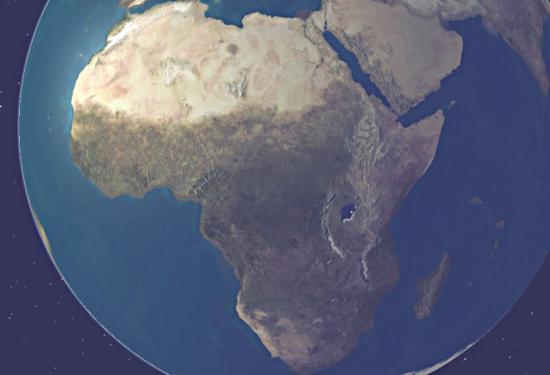BY LETTER
Africa
Galactography > Places and Locales
Galactography > Other Major Polities, Empires, and Meta-Empires > Solsys Organisation
Galactography > Other Major Polities, Empires, and Meta-Empires > Solsys Organisation
 Image from Steve Bowers | |
| North Africa has become even drier since the onset of the Gaiacene Ice Age | |
Old Earth continent between the Atlantic and Indian oceans. With an area of 30,303,000 square kilometers, it is the second-largest continent on the planet after Asia. Africa was an early centre of hominid evolution and the probable birthplace of Homo sapiens sapiens. It gave rise to several important human civilizations during the Agricultural Age but was eclipsed by European and later by Asian polities beginning in the 15th century CE (6th century BT) and did not produce any major world powers until the Interplanetary Age.
Africa was the birthplace of the hominid line; early hominids date from the early Pliocene 4 to 5 million years ago, and human habitation on the continent is as old as the species itself. Agriculture, beginning with imported species and ideas to the lower Nile from nearby Southwest Asia and from separate developments perhaps based on the same concepts but employing entirely new species from centres in Ethiopia, the Sahel, and West Africa, dates from 6000 BCE (8000 BT). Africa's first great civilizations began in Egypt around 3400 BCE (5400 BT). The northern coast was essentially a part of Mediterranean (Southwest Asian and European) history, but in addition to Egypt and Nubia, both the Ethiopian and West African regions later developed clusters of city-building cultures, and the eastern coast developed a series of trade cities. The period of European colonialism and domination began in the 15th century CE (5th century BT), and proceeded through to the close of the Industrial Age, beginning with trade in gold, slaves, and ivory. An early prosperous nation was South Africa, a nation created and in its early years dominated by European immigrants. Most other African nations attained independence during the Atomic Age, but the area suffered greatly from economic poverty, ethnic bloodshed and civil war. During the Information Age the legacy of AIDS and the bloody rewriting of boundaries to fit ethnicity served to hold it back for a long time.
By the early to middle 2nd century AT (late 21st and early 22nd centuries CE), the spread of cheap information technology increased literacy, new biotechnologies allowed increases in agricultural production and a reduction in the power of the continent's many endemic diseases, new tropical and subtropical energy resources became common, and these together with the growing online economy eventually enabled Africa to become prosperous. The population of Africa grew to more than four billion, making it the second-most populous continent on Earth.
Some states like Nigeria achieved Western-comparable levels as early as the late 1st century AT. During this time both India and China developed strong trade and cultural links with the southern half of Africa, and had significant influence on African culture in the southern regions, while the northern portions of the continent tended to be part of the network of Islamic polities. During the Interplanetary Age there were some interesting developments as tribal ethnicities asserted themselves in more constructive ways. The construction of the early space elevators (beanstalks) in Gabon and later in Kenya, and the rise of energy and information centres like the Republique du Chad led to a renaissance of African cultural and political influence. One of the more notable of the African-derived colonies off-planet was CisLunar Orbital Zulu, which actually survived the Technocalypse reasonably intact and persisted through the Dark Ages, eventually to become an important member polity in the early First Federation.
In the Current Era many worlds still show discernibly African influences. Notable examples include Wega, Ikere, Negsoa, New Zaire, Wadai, Yoruba, and the Ubuntu habs that were important in the foundation of the Communion of Worlds.
Modern Africa has been restored by GAIA to its pre-civilization ecological splendour in the time since the Great Expulsion, and orbital imaging confirms that it once again shows the most diverse mammalian fauna on the planet. Species restored through lazurogenics include not only casualties of the Great Dying such as the quagga and the white rhinoceros, but a number of Pleistocene biota as well. A few humans, most of them gengineered to match the appearance of the aboriginal populations, do remain as agents of GAIA, together with an equally thin population of rianths and provolves. Most of the great cities and arcologies of the Interplanetary Age have vanished without a trace, though GAIA has permitted such ancient historical treasures as the Great Pyramids and the first Azanian arcology. Offworlders are restricted to a very short list of sites.
Related Articles
Appears in Topics
Development Notes
Text by M. Alan Kazlev and Stephen Inniss
Ice Age Earth texture by Don Edwards
Initially published on 10 September 2001.
Ice Age Earth texture by Don Edwards
Initially published on 10 September 2001.






